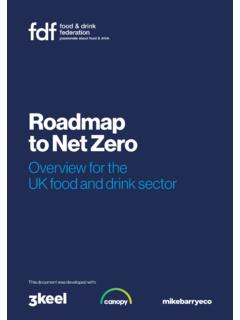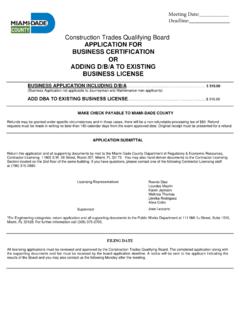Transcription of INDUSTRY GUIDANCE ON SETTING PRODUCT SHELF-LIFE
1 Foreword & BackgroundAdditional sources of informationGlossary of termsDo s and Don tsValidating the SHELF-LIFE proposed for a foodFactors affecting shelf-lifeINDUSTRY GUIDANCE ON SETTING PRODUCT SHELF-LIFEA pplication of minimum durabilityNovember 2017, Version 1 Page 2 Foreword & BackgroundAdditional sources of informationGlossary of termsDo s and Don tsValidating the SHELF-LIFE proposed for a foodFactors affecting shelf-lifeApplication of minimum durabilityINDUSTRY GUIDANCE ON SETTING PRODUCT SHELF-LIFEFood waste is an issue that all parts of society can unite in reducing.
2 The food and drink INDUSTRY has a pivotal role in ensuring that consumers understand the date marks on food and drink products and use them in support of food safety as well as waste reduction. It is the responsibility of Food Business Operators (FBOs) to set shelf lives such that food safety is assured whilst at the same time ensuring that no safe and high quality food is discarded due to inappropriate date marking. Working with organisations such as WRAP, it is our shared ambition to deliver environmental benefits within a commercial context, bringing long term mutual outcomes for all , the shelf life of a food must be assessed carefully and with the full knowledge of the risks involved, to avoid putting the consumer and ultimately the Food Business Operator (FBO) at risk.
3 SETTING SHELF-LIFE typically involves a number of steps as outlined below. This often includes SHELF-LIFE studies which aid in determining the length of time the PRODUCT will meet certain standards in relation to parameters such as microbiology, taste, appearance, vitamin levels and smell. To note the EU regulations referenced in this document may be subject to change after the UK exits the GUIDANCE is designed to help FBOs engaged in the production or sale of any category of food and ingredients to assign the most appropriate expiry date for their PRODUCT .
4 It must however be noted that this GUIDANCE does not replace the need for technical expertise which should be sought if it is not available within a food food waste, without any compromise to the safety of food, is a commitment we at the Food Standards Agency share with the FDF. I welcome the publication of this sensible GUIDANCE on SETTING PRODUCT shelf life, and explaining what factors affect the expiry date of a food PRODUCT . This is another welcome step towards preventing safe food from going to Hancock.
5 Chairman of the Food Standards AgencyFOREWORDF oreword & BackgroundPage 3 Foreword & BackgroundAdditional sources of informationGlossary of termsDo s and Don tsValidating the SHELF-LIFE proposed for a foodFactors affecting shelf-lifeApplication of minimum durabilityINDUSTRY GUIDANCE ON SETTING PRODUCT SHELF-LIFEThe application of each type of expiry date is laid down in the Food Information to Consumers Regulation (Regulation (EU) ) as well as in other GUIDANCE documents and so will not be covered in detail the exception of a number of designated foods under the Food Information to Consumers Regulation (Regulation (EU) ) it is a mandatory requirement that foods carry a use by date or the date of minimum durability in the form of a best before , in summary the terms Use By and Best Before are not interchangeable and should be applied as follows.
6 APPLICATION OF MINIMUM DURABILITYThe type of expiry date must therefore be taken into account when reviewing the SHELF-LIFE that is assigned to ingredients, work in progress or products that are ready for sale. We discourage the use of Use By dates as a default for unsubstantiated of minimum durabilityUSE BY: Must be used for those foods which are highly perishable from a microbiological point of view. After a relatively short period, these foods are likely to present a risk of food poisoning, and so this relates to the safety of the food.
7 Use By expires at midnight on the date shown. Typically, this form of date coding is found on fresh and ready to eat foods such as cream cakes or cooked meat. After the use by date food is deemed unsafe and it is a criminal offence to sell BEFORE/BEST BEFORE END: This kind of expiry date is used to indicate the period for which a food can reasonably be expected to retain its optimal condition and so relates to the quality of the food. This is the point at which the taste or eating quality may begin to decline.
8 The food will still be safe to eat beyond this point but it will not be at its best. Legally food that has passed the best before date and is still fit for human consumption can be sold. Commonly it will therefore be found on items such as ambient, dried or frozen foods. In view of the vast range of food products, the expected shelf life related to the quality of the PRODUCT can range from a few days (bread and baked goods) to greater than a year (canned goods, dry goods, frozen food). Similarly, the best before date accommodates the wide range of shelf life applied to such products.
9 Accordingly, the Regulations recognise that the format of the coding needs to be flexible for the range of dates covered. For a shelf life under 3 months, an indication of the day and the month is sufficient; between 3 months and 18 months an indication of the month and year is sufficient; for more than 18 months, an indication of the year is the minimum required. Page 4 Foreword & BackgroundAdditional sources of informationGlossary of termsDo s and Don tsValidating the SHELF-LIFE proposed for a foodFactors affecting shelf-lifeApplication of minimum durabilityINDUSTRY GUIDANCE ON SETTING PRODUCT SHELF-LIFE1.
10 RAW MATERIALS If incorporated into another PRODUCT without being processed or significantly changed ( chilled ham placed on a chilled raw pizza or included in a sandwich), the life of the final PRODUCT should not exceed the life declared for the raw material. If a raw material is changed during processing ( by being cooked) or if the storage requirements change ( chilled raw material but frozen final PRODUCT ) the life given to the final PRODUCT should be re-assessed. The food safety controls used to set the raw material life should be understood to ensure that any impact a change may have is understood.













